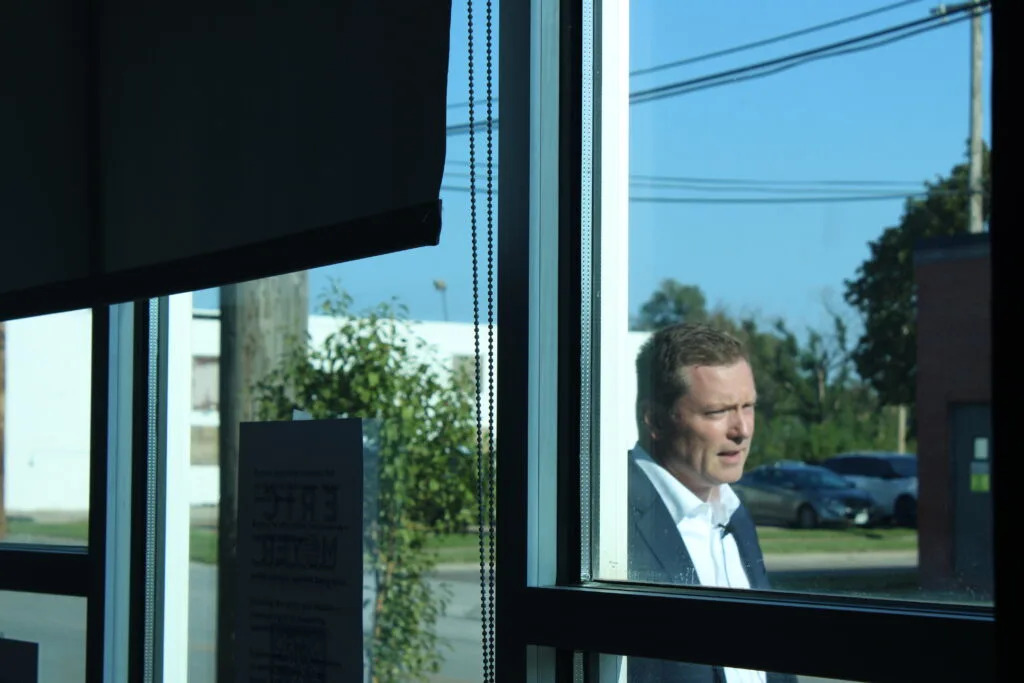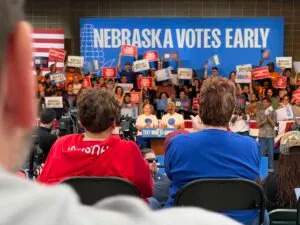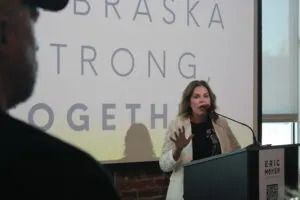
Eric Moyer talking to reporters in Lincoln before his 1st Congressional District campaign kickoff event on Aug 14, 2025. (Juan Salinas II/Nebraska Examiner)
LINCOLN — In a crowded coworking space on Lincoln’s Y Street this month, 1st Congressional District Democrats gathered to meet their man running against Republican U.S. Rep. Mike Flood.
Congressional candidate Eric Moyer told attendees at his kickoff event that he wants to create a spark.
Nebraska Democrats hope he’s onto something. They want the backlash to the second Trump administration to help them make gains in 2026, as national Democrats attempt to emerge from the political wilderness and address a weaker national brand than President Donald Trump or Republicans.

“Nebraska is special,” Moyer told the crowd. “I believe Nebraska can lead this nation into a better future.”
The good news for Democrats: Recent polling shows the party holds a slight lead in the head-to-head matchup for the generic congressional ballot, which means likely voters told pollsters they would pick a random Democrat over a random Republican. And Democrats nationwide are more energized than Republicans about next year’s elections.
Nebraska Democratic Party Chair Jane Kleeb, who is also a vice chair of the Democratic National Committee, says a successful 2026 starts with winning the 2nd District U.S. House race in the Omaha area. It continues with registering at least 10,000 more Democrats in the state. And the party wants to make gains in the state Legislature, where Democrats and a handful of legislative moderates have a tenuous hold on the ability to filibuster — needing 17 seats or 17 votes to stop controversial legislation.
Kleeb would like the party to win a statewide race again, too, and it’s been done before. Democrats held both U.S. Senate seats and the Governor’s Mansion as recently as the late 1990s. Democrats have said they have a potential candidate considering a race against Nebraska Gov. Jim Pillen, a Republican.
“The momentum is here,” Kleeb told the Examiner. “The fundraising is going to be there. We have to prove that we can now win this big [2nd District] seat.”
For Democrats, this may sound like a familiar tune. But the status quo in the 2nd District has changed. Omaha now has a Democratic mayor for the first time in more than a decade, and Republican U.S. Rep. Don Bacon announced in June that he is not running for reelection in 2026.
Democrats have seen growth in city elections in Omaha and Lincoln, and they continue winning down-ballot races in a state where registered Republicans outnumber them roughly 2 to 1. The Nebraska Republican Party, in recent years, has focused more attention on lower-profile races in response.
News of Bacon not running has Democrats lining up to run next year in a competitive district where the party’s nominees have lost by single digits four straight times. The loss on incumbent advantage has local and national political experts viewing the 2nd District as a possible pickup opportunity for the party.
The Democrats’ crowded field includes State Sen. John Cavanaugh of Omaha, Douglas County District Court Clerk Crystal Rhoades, newcomer Denise Powell and Navy veteran Kishla Askins.
SUBSCRIBE: GET THE MORNING HEADLINES DELIVERED TO YOUR INBOX
Some Democrats and pundits discuss this year’s city election as a hint of a possible blue tide for the state’s second-largest party to capitalize on, although a handful of observers acknowledge that the fundamentals of the Omaha area’s slightly right-leaning swing district haven’t changed.
Nationally, the Nebraska midterms are emerging as critical for the party attempting to retake the House. Locally, next year could determine whether the Legislature continues its drift toward a more combative brand of Republicanism and away from George Norris’ nonpartisan tradition.
The question of whether Nebraska Democrats can seize the moment looms over the next 14 months.
Recent history isn’t on the Democrats’ side. The party has tried for years to win the House seat and come up short. The one exception was 2014, when State Sen. Brad Ashford of Omaha, a former Republican, upset GOP U.S. Rep. Lee Terry for a term. Bacon beat Ashford in 2016. Ashford was the last Democrat in the state’s federal delegation.
In the statehouse, Democrats have lost some ground. The GOP won 33 of 49 seats in 2022, the number needed to break a filibuster in the officially nonpartisan Legislature. Republicans maintained that supermajority in 2024.
“A test for the party”
The 2nd District is the state’s most politically divided and diverse, with all of urban Douglas and rural Saunders Counties, and a slice of suburban western Sarpy County.
Douglas County Democratic Party Chair C.J. King said he considers Bacon’s retirement “handwriting on the wall.” He sees the momentum is shifting.
National and state GOP strategists acknowledge that an open-seat 2nd District race is winnable for Democrats, but they emphasize that Republicans can win with the “right candidate and the right messaging.”
Bacon, during his retirement announcement in June, warned Republicans not to get dragged to the right in the primary, because they won’t be able to “win the general.” He told reporters that “in this District, you’ve got to win swing voters.”
Bacon has been credited for striking that balance with a conservative voting record, an emphasis on national security, support for federal spending on local priorities and a willingness to sometimes criticize President Donald Trump.
This has helped Bacon fend off Democratic challengers. Last year, Bacon beat former State Sen. Tony Vargas by less than two percentage points. GOP strategists have emphasized the importance of Republicans of winning nearly 50% of the vote in Douglas County, as well as securing a good chunk of independent voters. They see it as a path to victory.
Bacon, while he hasn’t won a majority of Douglas County voters, has never won less than 48% of the vote there. The GOP also points to five Republicans having won municipal races in the county since 2018.
“This seat is tougher without Bacon, but he’s not special,” a House Republican strategist said in June. “It can be done.”

Zach Bannon, a National Republican Congressional Committee spokesman, said the party is confident it can keep Nebraska’s 2nd District red as Democrats “pile into a clown bus of a messy and expensive primary.”
“Nebraskans know Republicans are the party of common sense that delivers real results,” Bannon said.
The GOP primary race for NE-02 includes two Republicans, Omaha City Council Vice President Brinker Harding and former State Sen. Brett Lindstrom of Omaha.
When the GOP majority in the Legislature redrew Nebraska’s congressional maps in 2021, it did so in a way that shored up 2nd District Republicans by swapping some Democratic-voting residents in suburban Sarpy County with more reliably Republican-leaning residents of rural Saunders County. The district has more registered Republicans than Democrats, according to the latest data from the Secretary of State’s office.
Paul Landow, a retired University of Nebraska at Omaha political scientist, said if turnout is “exceptionally high and if the party unites behind a “strong candidate,” the Democrats could win the 2nd District, but it won’t be easy.
“It’s still a Republican lean district, even on a good day,” Landow said.
King, of the Douglas County Democrats, said the party has strong candidates and a key motivating factor on its side for 2026 — fear.
“There’s an unfortunate thing in politics … fear and hate seem to be the motivating factors,” King said. “There’s a lot of fear that the Democrats need to get off their butts and do something, or else it can only get worse.”
National Democratic strategists are prioritizing the 2nd District and leaving nothing to chance. Democratic Congressional Campaign Committee spokesperson Madison Andrus said Democrats would “spend the next [14] months earning every single vote.” Kleeb called winning the congressional race “a test for the state party.”
National and state Democrats are banking on the current political climate surrounding Trump’s budget and tax bill that passed earlier this summer, which polling indicates is unpopular among Americans. Kleeb said the party can capitalize statewide on people’s frustrations with Trump.
The balance of the Statehouse
The Nebraska GOP and its legislative candidates have built a narrow supermajority in the statehouse when the party’s members stick together on controversial votes, which isn’t always the case.
Democrats and progressive-leaning nonpartisans hold 16 seats, meaning they must convince at least one Republican to filibuster legislation they find objectionable, a tactic the Unicameral minority has long used to stall or kill legislation lacking consensus.
In theory, Republicans could pass the majority party’s agenda without crossing the aisle, but some Republicans have sided with the minority on controversial issues including defeating the push to switch the state’s presidential elections to winner-take-all.
Both parties are jockeying to gain seats in Lincoln. The stakes are real: Republicans can strengthen their majority to the point that a handful of moderate conservatives would hold less sway, essentially neutering the filibuster.
Democrats are attempting to end the supermajority and restore the filibuster’s original strength, seeking more negotiating power on legislation. Party officials say they aim to gain two seats.

“That’s going to be difficult, no question,” Kleeb said. “But there’s a seat in Gretna … there’s a couple of seats still in Douglas County that we think are on the table. I think there is a path.”
The Legislature could prove a pivotal point in the Democratic primary for Congress, too, in the 2nd District. Omaha’s John Cavanaugh would potentially have to vacate his seat if voters send him to Washington, allowing Pillen, a Republican, to appoint his successor.
State Sen. Megan Hunt of Omaha, a progressive nonpartisan who regularly votes with Democrats, recently said that is part of why she is watching the Democratic primary closely. Hunt said losing any more seats could widen the door for “extremist policies that hurt working people” and “target vulnerable communities.”
“My hope is that we don’t lose that last line of defense,” Hunt said.
Why is there no Democrat in the Senate race?
Kleeb, in an interview with the Examiner, reaffirmed the party’s alliance with populist candidate Dan Osborn against GOP U.S. Sen. Pete Ricketts. She repeated her belief that “a coalition of Dems, Indys, and Republicans can beat Ricketts and break up the one-party rule.”
However, party officials say that is not an official endorsement. Republicans have used the alliance to try painting Osborn, a registered nonpartisan, as a Democrat. Osborn has said he would caucus with neither party in the Senate, and he has described the challenges of being labeled a Democrat in a red state like Nebraska.
ActBlue, a fundraising tool often used by Democrats, recently changed its rules to include independent candidates on a “case-by-case” basis, according to Axios. The Ricketts campaign has pointed out Osborn’s use of ActBlue. Some other nonpartisan and independent candidates in different states have avoided using the fundraising tool to keep from being associated with the Democratic Party.

Osborn, who in 2024 ran a closer-than-expected bid against U.S. Sen. Deb Fischer, R-Neb, is trying again against Ricketts. That’s part of why Republicans are attacking Osborn sooner this time.
Osborn’s bid comes as Democrats are trying to repair their relationship with the working class. Trump has made gains with blue-collar voters and voters of color. Some working-class Americans have warned Democrats not to expect frustration with Trump to be enough to swing them.
Kleeb said the Democratic Party needs to respect voters from all classes and be comfortable talking to them. She says Democrats must appeal to voters who hang out in dive bars and wine bars.
“That’s how we’re going to be successful,” Kleeb said. “I think this cycle we’re on that path.”
Landow, the retired UNO professor, said Democratic aspirations of winning beyond the 2nd District and legislative races aren’t impossible, because “nothing’s impossible.” But he said they might not be “realistic.”
“There are just too many Republicans in those other districts and statewide,” Landow said. “For a Democrat to pull it off anywhere but Omaha would be some sort of amazing occurrence.”
But don’t tell the Lincoln-area Democrats who turned out with high spirits for Moyer’s kickoff event. As one attendee said, Democrats “at least have to try.”








Comments